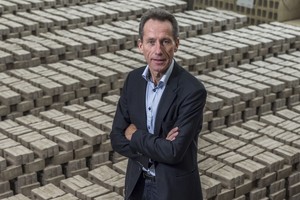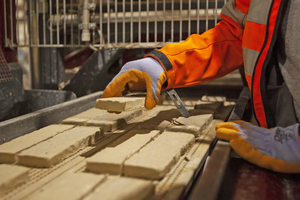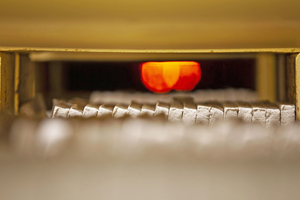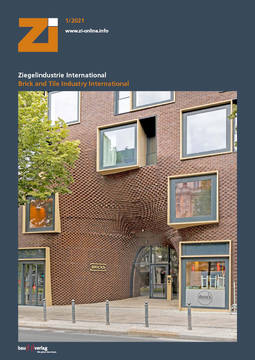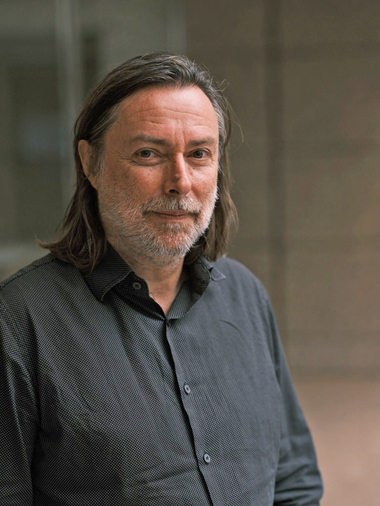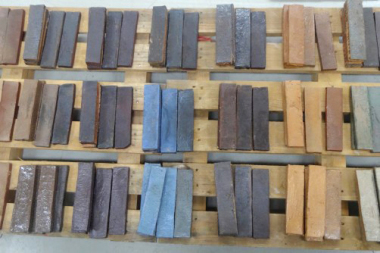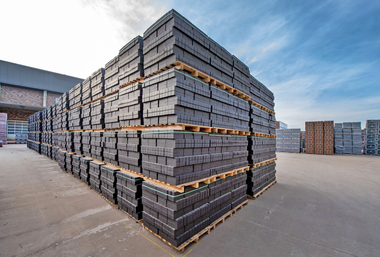Clay bricks with a future – the energy transition in the construction materials sector
Europe has set itself the aim of achieving CO2-neutral industrial production by the year 2050. Preparations are currently underway for the introduction of Phase 4 of the European Emissions Trading System (ETS). But bricks must first be fired in a kiln before they can demonstrate their physical strengths in construction. This requires a lot of energy. Does fired clay still have a future against the background of these ambitious goals? The Zi editors spoke to Jean-Pierre Wuytack, CEO at Vandersanden, about the prospects.
Mr. Wuytack, does traditional clay brick still fit in with ambitious environmental goals?
Jean-Pierre Wuytack: I can answer confidently: Yes! Facing bricks and clay pavers are as alive and effective as ever as building materials! Even in these turbulent times, we are still looking ahead at Vandersanden, and we are working on our plans for the near but also more distant future. After all, at Vandersanden we are proud to think in terms of generations rather than just in years. Accordingly, I am extremely optimistic that our next generation will still be producing Vandersanden bricks, too.
What do your plans look like?
Jean-Pierre Wuytack: The facade brick and brick production will change profoundly. Energy efficiency is a key driver for buyers, project developers and suppliers. We are already working on planning and realizing this transformation because our ambition is to be at the forefront of sustainability.
In our view, the transition will be completed in two steps. In the first phase – up to 2030 – we want to drastically reduce the energy emissions of our facade bricks and clay paver production process and of our products. Then we’ll define the horizon up to 2050. By then, we shall have achieved a one-hundred-percent green, energy-neutral firing process for our bricks and pavers.
How do you see bricks in the context of sustainability?
Jean-Pierre Wuytack: Bricks are a very durable construction material. They are made from natural, often recyclable raw materials like clay and sand. In the production of our facing bricks and clay pavers, we produce virtually no waste.
But during the production of bricks we emit CO2: during firing and even more so during drying. In numbers: Vandersanden emits around 60 000 tonnes CO2 at its Belgian facing brick plants at Bilzen and Lanklaar and around 25 000 tonnes CO2 at its facing brick plants in Beek and Hedikhuizen in the Netherlands.
This may be only a very small percentage of the industry’s total annual CO2 emissions – 18 million tonnes per year in Belgium – nevertheless we don’t want to downplay it. When it comes to sustainability, everyone should make an exemplary contibution!
How does Vandersanden want to become more sustainable in concrete terms?
Jean-Pierre Wuytack: The most important development is currently the “slimming down” of our facing bricks. This is about using fewer resources, so that facing bricks are becoming much thinner. In the most extreme form that means switching from facing bricks to the much thinner brick slips.
A standard facing brick today measures ten centimetres in thickness. But, in our view, the times when our facades were clad with such a thick layer of bricks are now behind us. Modern bricks need a thickness only of six and a half to eight centimetres. Not only is there a saving in the materials needed, we consume much less energy in the production process, too. Some brick models are not that much thinner than traditional facing bricks, but save material thanks to depressions in the brick. Up to now, a maximum of 30 percent material can be saved in this way. The slimming process has by no means reached an end at this point. Vandersanden is already working on using the trend for the production of brick slips with a thickness of just 1.5 cm. These can be produced by sawing whole facing bricks into strips.
Incidentally, Vandersanden was incidentally the first manufacturer to ecologically produce hand-moulded brick slips. We form these ECO brick slips before drying and firing instead of sawing them out of standard-sized facing bricks. That saves a huge amount of material and effort. In addition, we don’t produce any unnecessary waste that we can’t use further in the conventional process.
So that means a considerable saving in resources?
Jean-Pierre Wuytack: With the just two-centimetre-thick facing brick slips shaped in the mould, the raw materials needed are reduced by an impressive 80 percent compared with traditional brick slips. The energy consumption is halved. For this, strips of clay are placed into setters and fired in a tunnel kiln. Vandersanden is, however, planning in the near future to fire these strips of clay to brick slips in a roller kiln so that the energy consumption will also be reduced by 80 percent.
With the lower quantity of material used, we are saving not only energy and raw materials, but also drastically reducing emissions during transport. Another plus point: with the use of thinner facing bricks or brick slips, more space is available for insulation in house walls.
How do you see the discussion on CO2-neutral facing bricks?
Jean-Pierre Wuytack: Thanks to the development of ECO brick slips, low-CO2 facing bricks are already within reach. Then, it is no longer that difficult to take the next step and produce a CO2-neutral or even zero-emissions brick, In view of the CO2-intensive production of bricks on the basis of fossil fuels, today this is, however, still something for the future. However, we want to meet this challenge by 2050 – even if we have to overcome a series of approval-related hurdles, like, for example, permission for the production of green electricity with wind turbines.
In the ecological production of bricks, the CO2 neutrality also plays a part. What strategy are you pursuing here?
Jean-Pierre Wuytack: With the new Vandersanden standard of material-reduced brick, we shall in future need less energy for brick production, Then it will be easier to work completely with renewable energies. We are already extensively using the existing technical possibilities for the generation of green energy. For instance, we have installed solar collectors on all roofs of our factories and are planning a first wind power installation at our Lanklaar site. However, it has proven a difficult and lengthy process to obtain licences for wind power plants.
In our clay paver plant in Tolkamer, we have recently installed a new extremely economical kiln that replaces the three older kilns and lowers energy consumption by around 30 percent.
How do you see research and development in the context of renewable energies?
Jean-Pierre Wuytack: Of course, we are investing in new technologies, too. Hydrogen could be very interesting if we could obtain it using wind or solar energy. But we are not waiting for that, and instead, we are sponsoring an innovative study project at KU University of Leuven for the high-efficiency production of hydrogen gas with the help of solar collectors.
CO2-neutrality is the clear goal on our road ahead in the years to come. Thanks to our modern, economical brick slips and the greening of our production process, at Vandersanden we are on the right track for CO2-neutral production by 2050 at the latest. We are even hoping that we shall already be able to meet the zero-emissions standard by then. But here too, we aren’t just sticking to the production process, but are including the product itself on our roadmap to climate neutrality.
Are there any new energy transition projects at Vandersanden? Please give us an outlook over developments here.
Jean-Pierre Wuytack: We are currently optimistic that we shall soon be able to produce even CO2-negative bricks. These are bricks that absorb more CO2 than emitted during their production. In this way, Vandersanden bricks would make a valuable contribution to a functioning circular economy. This trail-blazing innovation has our full attention. We firmly believe in they can be realized, as the first product developments are extremely promising.
Let me just emphasize: Vandersanden isn’t standing still with regard to sustainability, but will continue to be an ecological forerunner. For us, the decorative facing brick has to move with the times. Thinner and therefore low-CO2 or environmentally friendly facing bricks are only the first piece in our eco-puzzle at Vandersanden. You can rely on us giving the construction sector the necessary impetus to contribute to the energy transition in the brick industry.
Herr Wuytack, thanks for the interesting conversation!
Interview: Wolfgang Deil,
Editor Zi International
Über Vandersanden
Mit zehn Produktionsstätten in Belgien, den Niederlanden, Frankreich, Deutschland und Großbritannien sowie mehr als 700 Mitarbeitern ist Vandersanden der größte familiengeführte Ziegelproduzent Europas. Das Unternehmen produziert zirka 550 Millionen Ziegel pro Jahr für den europäischen Markt und ist laut eigenen Angaben nicht nur Marktführer für Handformverblender in Belgien und Deutschland, sondern auch für das Segment Pflasterklinker in den Niederlanden. In Deutschland betreibt Vandersanden zwei Ziegelwerke, in der Oberlausitz und in Glückstadt. Jaak Vandersanden gründete die Traditionsziegelei Vandersanden 1925 im belgischen Spouwen, unweit der deutschen Grenze.

